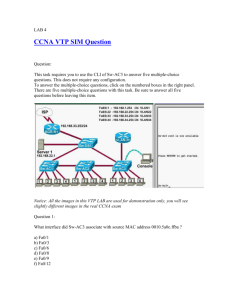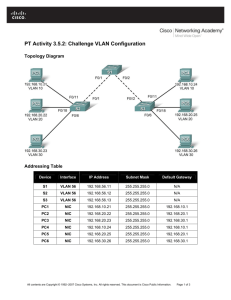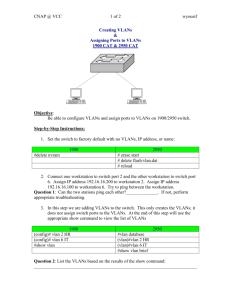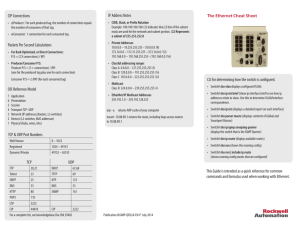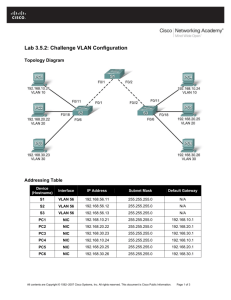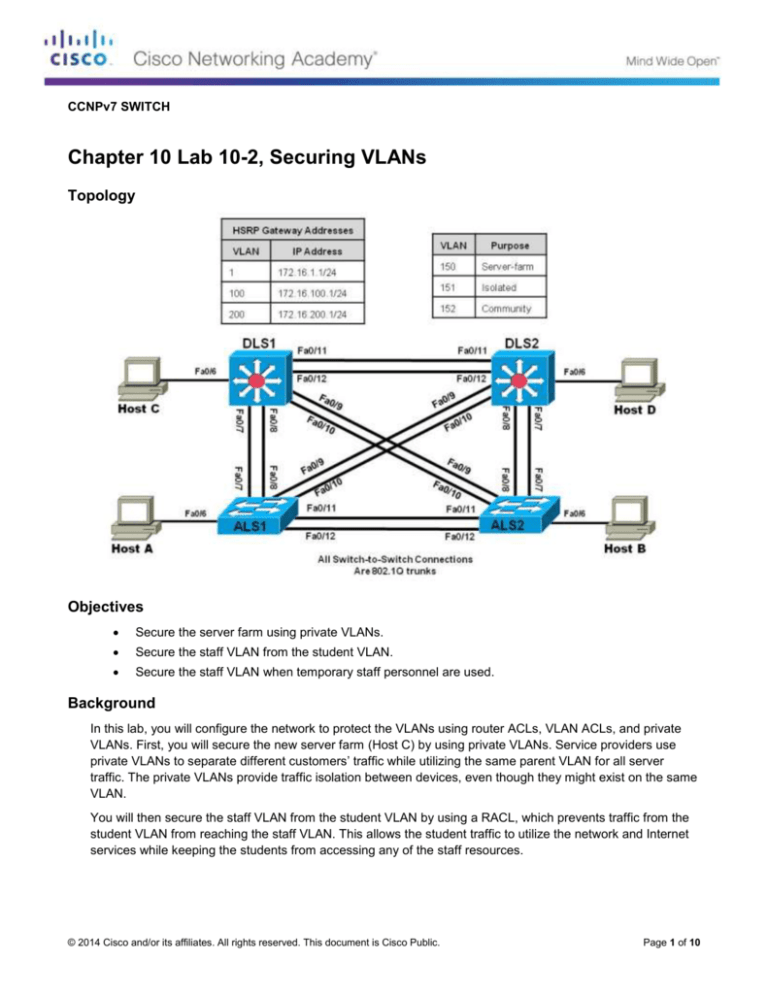
CCNPv7 SWITCH
Chapter 10 Lab 10-2, Securing VLANs
Topology
Objectives
Secure the server farm using private VLANs.
Secure the staff VLAN from the student VLAN.
Secure the staff VLAN when temporary staff personnel are used.
Background
In this lab, you will configure the network to protect the VLANs using router ACLs, VLAN ACLs, and private
VLANs. First, you will secure the new server farm (Host C) by using private VLANs. Service providers use
private VLANs to separate different customers’ traffic while utilizing the same parent VLAN for all server
traffic. The private VLANs provide traffic isolation between devices, even though they might exist on the same
VLAN.
You will then secure the staff VLAN from the student VLAN by using a RACL, which prevents traffic from the
student VLAN from reaching the staff VLAN. This allows the student traffic to utilize the network and Internet
services while keeping the students from accessing any of the staff resources.
© 2014 Cisco and/or its affiliates. All rights reserved. This document is Cisco Public.
Page 1 of 10
Chapter 10, Lab 10-2 Securing VLANs
Lastly, you will configure a VACL that allows a host on the staff network to be set up to use the VLAN for
access but keeps the host isolated from the rest of the staff machines. This machine is used by temporary
staff employees.
Note: This lab uses Cisco Catalyst 3560 and 2960 switches running Cisco IOS 15.0(2) IP Services and LAN
Base images, respectively. The 3560 and 2960 switches are configured with the SDM templates “dual-ipv4and-ipv6 routing” and “lanbase-routing”, respectively. Depending on the switch model and Cisco IOS Software
version, the commands available and output produced might vary from what is shown in this lab. Catalyst
3650 switches (running any Cisco IOS XE release) and Catalyst 2960-Plus switches (running any supported
Cisco IOS image) can be used in place of the Catalyst 3560 switches and the Catalyst 2960 switches.
Required Resources
2 switches (Cisco 2960 with the Cisco IOS Release 15.0(2)SE6 C2960-LANBASEK9-M image or
comparable)
2 switches (Cisco 3560 with the Cisco IOS Release 15.0(2)SE6 C3560-IPSERVICESK9-M image or
comparable)
4 PCs
Ethernet and console cables
Step 1: Load and verify the configurations from lab 10-1.
a. Verify that the configurations from Lab 10-1 are loaded on the devices by issuing the show vtp status
command. The output should show that the current VTP domain is SWPOD, and VLANs 100 and 200
should be represented in the number of existing VLANs. The output from switch ALS1 is shown as an
example. If the switches are not configured properly, erase the startup config, delete the vlan.dat file, and
load the configurations saved at the end of lab 10-1.
Note: If you are loading the configurations from Lab 10-1, they do not include VLAN and VTP commands.
You must first configure ALS1 and ALS2 as VTP clients and then create VLANs 100 (staff) and 200
(student) and the VTP domain name on DLS1. Refer to Lab 10-1 for assistance if necessary.
ALS1# show vtp status
VTP Version capable
: 1 to 3
VTP version running
: 2
VTP Domain Name
: SWPOD
VTP Pruning Mode
: Disabled
VTP Traps Generation
: Disabled
Device ID
: 0017.95d1.8b80
Configuration last modified by 172.16.1.3 at 3-1-93 01:39:36
Feature VLAN:
-------------VTP Operating Mode
Maximum VLANs supported locally
Number of existing VLANs
Configuration Revision
MD5 digest
:
:
:
:
:
Client
255
7
3
0xAE 0xEB 0x3A 0xEB 0x28 0x23 0x1D 0x85
0x7E 0x8C 0x70 0x56 0x03 0x70 0x29 0xB2
Will VLAN information be stored in NVRAM when this device is rebooted? Explain.
_______________________________________________________________________________
b. Issue the show vlan command on DLS1. The student and staff VLANs should be listed in the output of
this command.
© 2014 Cisco and/or its affiliates. All rights reserved. This document is Cisco Public.
Page 2 of 10
Chapter 10, Lab 10-2 Securing VLANs
DLS1# show vlan brief
VLAN Name
Status
Ports
---- ------------------------------- --------- ----------------------------1
default
active
Fa0/1, Fa0/2, Fa0/3, Fa0/4
Fa0/5, Fa0/6, Fa0/13, Fa0/14
Fa0/15, Fa0/16, Fa0/17, Fa0/18
Fa0/19, Fa0/20, Fa0/21, Fa0/22
Fa0/23, Fa0/24
Gi0/1, Gi0/2
99
Management
100 staff
active
200 student
active
1002 fddi-default
act/unsup
1003 token-ring-default
act/unsup
1004 fddinet-default
act/unsup
1005 trnet-default
act/unsup
How many of these VLANs are present by default?
_______________________________________________________________________________
c.
Issue the show interfaces trunk command on each switch. If trunking was configured properly in Labs
10-1, Fast Ethernet 0/7–0/12 should be in trunking mode on all switches.
DLS1# show interfaces trunk
Port
Fa0/7
Fa0/8
Fa0/9
Fa0/10
Fa0/11
Fa0/12
Mode
on
on
on
on
on
on
Encapsulation
802.1q
802.1q
802.1q
802.1q
802.1q
802.1q
Port
Fa0/7
Fa0/8
Fa0/9
Fa0/10
Fa0/11
Fa0/12
Vlans allowed on trunk
1-4094
1-4094
1-4094
1-4094
1-4094
1-4094
Port
Fa0/7
Fa0/8
Fa0/9
Fa0/10
Fa0/11
Vlans allowed and active in management domain
1,99,100,200
1,99,100,200
1,99,100,200
1,99,100,200
1,99,100,200
Port
Fa0/12
Vlans allowed and active in management domain
1,99,100,200
Port
Fa0/7
Fa0/8
Vlans in spanning tree forwarding state and not pruned
1,100,200
1,100,200
© 2014 Cisco and/or its affiliates. All rights reserved. This document is Cisco Public.
Status
trunking
trunking
trunking
trunking
trunking
trunking
Native vlan
666
666
666
666
666
666
Page 3 of 10
Chapter 10, Lab 10-2 Securing VLANs
Fa0/9
Fa0/10
Fa0/11
Fa0/12
1,100,200
1,100,200
1,100,200
1,100,200
What is the native VLAN for these trunk ports?
_______________________________________________________________________________
d. Issue the show standby brief command on DLS2.
DLS2# show standby brief
P indicates configured
|
Interface
Grp Pri P
Vl99
1
100 P
Vl100
1
100 P
Vl200
1
150 P
to preempt.
State
Standby
Standby
Active
Active
172.16.99.3
172.16.100.3
local
Standby
local
local
172.16.200.3
Virtual IP
172.16.99.1
172.16.100.1
172.16.200.1
For which VLANs is DLS2 the active router?
DLS2 is the active router for VLAN 200
_______________________________________________________________________________
What is the priority of the current root bridge for VLAN 200?
Based on the output of the show spanning-tree command, the priority is 24776.
_______________________________________________________________________________
Step 2: Configure private VLANs.
Private VLANs are an option when you have multiple devices in the same broadcast domain, but need to
prevent them from communicating from each other. A good example is in a server farm where the servers do
not need to receive other server's broadcast traffic.
In a sense, Private VLANs allow you to sub-divide the layer 2 broadcast domain. You are able to associate a
primary VLAN with multiple secondary VLANs, while using the same IP address space for all of the devices.
In this construct, the secondary VLANs can only communicate with the primary VLAN. The secondary VLANs
are restricted from directly communicating with each other.
Secondary VLANs are defined as one of two types; either COMMUNITY or ISOLATED. A secondary
community VLAN allows the hosts within the VLAN to communicate with one another and the primary VLAN.
A secondary isolated VLAN does not allow hosts to communicate with others in the same isolated VLAN.
They can only communicate with the primary VLAN.
A primary VLAN can have multiple secondary community VLANs associated with it, but only one secondary
isolated VLAN.
© 2014 Cisco and/or its affiliates. All rights reserved. This document is Cisco Public.
Page 4 of 10
Chapter 10, Lab 10-2 Securing VLANs
a. The first step is to configure the switches for the primary VLAN. Based on the topology diagram, VLAN
150 will be used for the new server farm. On VTP server DLS1, add VLAN 150, name the VLAN serverfarm and exit vlan config mode. Also configure DLS1 as the root bridge for VLANs 150, 151, and 152.
DLS1(config)# vlan 150
DLS1(config-vlan)# name server-farm
DLS1(config-vlan)# exit
DLS1(config)# spanning-tree vlan 150-152 root primary
Once this is complete, verify that VLAN 150 is preset in the database at DLS2
b. Configure interface VLAN 150 at DLS1 and DLS2:
DLS1(config)# interface vlan 150
DLS1(config-if)# ip address 172.16.150.1 255.255.255.0
DLS2(config)# interface vlan 150
DLS2(config-if)# ip add 172.16.150.2 255.255.255.0
b. Configure both switches in transparent mode for VTP using the vtp mode transparent global
configuration command. This is required to use PVLANs with VTP version 2.
DLS1(config)# vtp mode transparent
Setting device to VTP TRANSPARENT mode.
DLS2(config)# vtp mode transparent
Setting device to VTP TRANSPARENT mode.
c.
Configure DLS1 and DLS2 to contain the new PVLANs. Secondary PVLAN 151 is an isolated VLAN used
for Fast Ethernet port 0/6, while secondary PVLAN 152 is used as a community PVLAN for Fast Ethernet
ports 0/18–0/20. Configure these new PVLANs in global configuration mode. You also need to associate
these secondary VLANs with primary VLAN 150.
DLS1(config)# vlan
DLS1(config-vlan)#
DLS1(config-vlan)#
DLS1(config)# vlan
DLS1(config-vlan)#
DLS1(config-vlan)#
DLS1(config)# vlan
DLS1(config-vlan)#
DLS1(config-vlan)#
151
private-vlan
exit
152
private-vlan
exit
150
private-vlan
private-vlan
DLS2(config)# vlan
DLS2(config-vlan)#
DLS2(config-vlan)#
DLS2(config)# vlan
DLS2(config-vlan)#
DLS2(config-vlan)#
DLS2(config)# vlan
DLS2(config-vlan)#
DLS2(config-vlan)#
151
private-vlan
exit
152
private-vlan
exit
150
private-vlan
private-vlan
isolated
community
primary
association 151,152
isolated
community
primary
association 151,152
d. The private-vlan mapping interface configuration command permits PVLAN traffic to be switched
through Layer 3. Normally you would include all the secondary VLANs to allow for HSRP to work, but for
© 2014 Cisco and/or its affiliates. All rights reserved. This document is Cisco Public.
Page 5 of 10
Chapter 10, Lab 10-2 Securing VLANs
this example we will leave VLAN 151 off of DLS2 so we can demonstrate the isolation of VLAN 151.
Configure these commands for interface VLAN 150 on DLS1 and DLS2.
DLS1(config)# interface vlan 150
DLS1(config-if)# private-vlan mapping 151-152
DLS1(config-if)# end
DLS2(config)# interface vlan 150
DLS2(config-if)# private-vlan mapping 152
DLS2(config-if)# end
e. Verify the creation of the secondary PVLANs and their association with the primary VLAN using the show
vlan private-vlan command. Note that no ports are currently associated with these VLANs. This is
expected behavior.
DLS1#show vlan private-vlan
Primary
------150
150
Secondary Type
Ports
--------- ----------------- ----------------------------------------151
152
isolated
community
DLS2# show vlan private-vlan
Primary
------150
150
Secondary
--------151
152
Type
Ports
----------------- ----------------------------------------isolated
community
Will hosts assigned to ports on private VLAN 151 be able to communicate directly with each other?
_______________________________________________________________________________
f.
On DLS1, configure interface FastEthernet 0/6 so it is in private-vlan host mode and has association to
VLAN 150
DLS1(config)# interface fastethernet 0/6
DLS1(config-if)# switchport mode private-vlan host
DLS1(config-if)# switchport private-vlan host-association 150 152
DLS1(config-if)# exit
g. Use the show vlan private-vlan command and note that the ports configured are currently associated
with these VLANs.
DLS1#show vlan private-vlan
Primary
------150
150
Secondary Type
Ports
--------- ----------------- ----------------------------------------151
152
isolated
community
Fa0/6
h. On DLS2, configure the Fast Ethernet ports that are associated with the server farm private VLANs. Fast
Ethernet port 0/6 is used for the secondary isolated PVLAN 151, and ports 0/18–0/20 are used for the
secondary community VLAN 152. The switchport mode private-vlan host command sets the mode on
© 2014 Cisco and/or its affiliates. All rights reserved. This document is Cisco Public.
Page 6 of 10
Chapter 10, Lab 10-2 Securing VLANs
the interface and the switchport private-vlan host-association primary-vlan-id secondary-vlan-id
command assigns the appropriate VLANs to the interface. The following commands configure the
PVLANs on DLS2.
DLS2(config)# interface fastethernet 0/6
DLS2(config-if)# switchport mode private-vlan host
DLS2(config-if)# switchport private-vlan host-association 150 151
DLS2(config-if)# exit
DLS2(config)# interface range fa0/18 - 20
DLS2(config-if-range)# switchport mode private-vlan host
DLS2(config-if-range)# switchport private-vlan host-association 150 152
As servers are added to Fast Ethernet 0/18–20, will these servers be allowed to hear broadcasts from
each other? Explain.
_______________________________________________________________________________
_______________________________________________________________________________
i.
Use the show vlan private-vlan command and note that the ports configured are currently associated
with these VLANs.
DLS2# show vlan private-vlan
Primary
------150
150
Secondary
--------151
152
Type
----------------isolated
community
Ports
----------------------------------------Fa0/6
Fa0/18, Fa0/19, Fa0/20
j.
Configure HOST C on DLS1 interface f0/6 with an IP address in VLAN 150 (for example
172.16.150.50/24). Use 172.16.150.1 as the default gateway address.
k.
Configure HOST D on DLS2 interface f0/6 with an IP address in VLAN 150 (for example
172.16.150.150/24). Use 172.16.150.1 as the default gateway address.
l.
From HOST C, try to ping the following addresses - they should all work: 172.16.150.1 (DLS1),
172.16.150.2 (DLS2), 172.16.99.101 (ALS1).
m. From HOST C, try to ping HOST D (172.16.150.150). This should NOT work.
n. From HOST D, try to ping the following addresses - they should all work: 172.16.150.1 (DLS1),
172.16.99.101 (ALS1).
o. From HOST D, try to ping 172.16.150.2 (DLS2). This should NOT work.
Step 3: Configure RACLs between VLANs.
Configure router access control lists (RACLs) to separate the student and staff VLANs. The staff VLAN (100)
can access the student VLAN (200), but the student VLAN does not have access to the staff VLAN for
security purposes.
a. To deny the student subnet, use an extended IP access list on DLS1 and DLS2, and assign the access
list to the appropriate VLAN interfaces using the ip access-group acl-num {in | out} command.
DLS1(config)# access-list 100 permit tcp 172.16.200.0 0.0.0.255 172.16.100.0
0.0.0.255 established
DLS1(config)# access-list 100 permit icmp 172.16.200.0 0.0.0.255 172.16.100.0
0.0.0.255 echo-reply
© 2014 Cisco and/or its affiliates. All rights reserved. This document is Cisco Public.
Page 7 of 10
Chapter 10, Lab 10-2 Securing VLANs
DLS1(config)# access-list 100 deny ip 172.16.200.0 0.0.0.255 172.16.100.0
0.0.0.255
DLS1(config)# access-list 100 permit ip any any
DLS1(config)# interface vlan 200
DLS1(config-if)# ip access-group 100 in
DLS2(config)# access-list 100 permit
0.0.0.255 established
DLS2(config)# access-list 100 permit
0.0.0.255 echo-reply
DLS(config)# access-list 100 deny ip
0.0.0.255
DLS2(config)# access-list 100 permit
DLS2(config)# interface vlan 100
DLS2(config-if)# ip access-group 100
DLS2(config)# interface vlan 200
DLS2(config-if)# ip access-group 100
tcp 172.16.200.0 0.0.0.255 172.16.100.0
icmp 172.16.200.0 0.0.0.255 172.16.100.0
172.16.200.0 0.0.0.255 172.16.100.0
ip any any
in
in
b. Check the configuration using the show ip access-list and show ip interface vlan vlan-id commands.
DLS1# show access-lists
Extended IP access list 100
10 permit tcp 172.16.200.0 0.0.0.255 172.16.100.0 0.0.0.255 established
20 permit icmp 172.16.200.0 0.0.0.255 172.16.100.0 0.0.0.255 echo-reply
30 deny ip 172.16.200.0 0.0.0.255 172.16.100.0 0.0.0.255
40 permit ip any any
DLS1# show ip interface vlan 100
Vlan100 is up, line protocol is up
Internet address is 172.16.100.3/24
Broadcast address is 255.255.255.255
Address determined by non-volatile memory
MTU is 1500 bytes
Helper address is not set
Directed broadcast forwarding is disabled
Multicast reserved groups joined: 224.0.0.2
Outgoing access list is not set
Inbound access list is 100
<output omitted>
c.
After the access list has been applied verify the configuration in one of the following ways. Option 1 using
real hosts is preferred.
Option 1: Connect host PC-A to ALS1 port Fa0/6 in staff VLAN 100 and assign it IP address
172.16.100.15/24 with default gateway 172.16.100.1. Connect host PC-B to ALS2 port Fa0/6 in student
VLAN 200 and assign it IP address 172.16.200.15/24 with default gateway 172.16.200.1. Ping the staff
host from the student host. This ping should fail. Then ping the student host from the staff host. This ping
should succeed.
Option 2: On ALS1 set up a simulated host in VLAN 100 and one in VLAN 200 by creating a VLAN 100
and 200 interface on the switch. Give the VLAN 100 interface an IP address in VLAN 100. Give the VLAN
200 interface an IP address in VLAN 200. The following is a sample configuration on ALS1.
ALS1(config)# int vlan 100
ALS1(config-if)# ip address 172.16.100.100 255.255.255.0
© 2014 Cisco and/or its affiliates. All rights reserved. This document is Cisco Public.
Page 8 of 10
Chapter 10, Lab 10-2 Securing VLANs
ALS1(config)# int vlan 200
ALS1(config-if)# ip address 172.16.200.200 255.255.255.0
Ping the interface of the gateway for the staff VLAN (172.16.100.1) with a source of staff VLAN 100
(172.16.100.100) and then ping with a source of student VLAN 200. The pings from the student VLAN
should fail.
ALS1# ping 172.16.100.1 source vl100
Type escape sequence to abort.
Sending 5, 100-byte ICMP Echos to 172.16.100.1, timeout is 2 seconds:
Packet sent with a source address of 172.16.100.100
!!!!!
Success rate is 100 percent (5/5), round-trip min/avg/max = 1/205/1007 ms
ALS1# ping 172.16.100.1 source vl200
Type escape sequence to abort.
Sending 5, 100-byte ICMP Echos to 172.16.100.1, timeout is 2 seconds:
Packet sent with a source address of 172.16.200.200
.U.U.
Success rate is 0 percent (0/5)
What does a U signify in the output of the ping command?
_______________________________________________________________________________
_______________________________________________________________________________
_______________________________________________________________________________
_______________________________________________________________________________
Step 4: Configure VACLs.
Configure the network so that the temporary staff host cannot access the rest of the staff VLAN, yet still be
able to use the default gateway of the staff subnet to connect to the rest of the network and the ISP. You can
accomplish this task by using a VLAN ACL (VACL).
Because the temporary staff PC is located on DLS1 Fast Ethernet 0/3, the VACL must be placed on DLS1.
a. Change the configuration of DLS1 F0/6 so that the interface is associated with VLAN 100. To keep things
tidy, also remove the private vlan mapping on the interface as well:
DLS1(config)#interface f0/6
DLS1(config-if)#switchport mode access
DLS1(config-if)#switchport access vlan 100
DLS1(config-if)#no switchport private-vlan host-association 150 152
DLS1(config-if)#exit
b. Change the configuration of HOST C so that it is using the IP address 172.16.100.150/24 with the default
gateway set as 172.16.100.1
c.
Configure an access list on DLS1 called temp-host using the ip access-list extended name command.
This list defines the traffic between the host and the rest of the network. Then define the traffic using the
permit ip host ip-address subnet wildcard-mask command. Note that you must be explicit about what
traffic to match -- this isn't a traffic filtering ACL, it is a traffic matching ACL. If you were to leave the
second line of the example below out, pings would work.
DLS1(config)# ip access-list extended temp-host
© 2014 Cisco and/or its affiliates. All rights reserved. This document is Cisco Public.
Page 9 of 10
Chapter 10, Lab 10-2 Securing VLANs
DLS1(config-ext-nacl)# permit ip host 172.16.100.150 172.16.100.0 0.0.0.255
DLS1(config-ext-nacl)# permit icmp host 172.16.100.150 172.16.100.0 0.0.0.255
d. The VACL is defined using a VLAN access map. Access maps are evaluated in a numbered sequence.
To set up an access map, use the vlan access-map map-name seq# command. The following
configuration defines an access map named block-temp, which uses the match statement to match the
traffic defined in the access list and denies that traffic. You also need to add a line to the access map that
allows all other traffic. If this line is not added, an implicit deny catches all other traffic and denies it.
DLS1(config)# vlan access-map block-temp 10
DLS1(config-access-map)# match ip address temp-host
DLS1(config-access-map)# action drop
DLS1(config-access-map)# vlan access-map block-temp 20
DLS1(config-access-map)# action forward
DLS1(config-access-map)# exit
e. Define which VLANs the access map should be applied to using the vlan filter map-name vlan-list vlanID command.
DLS1(config)# vlan filter block-temp vlan-list 100
f.
Verify the VACL configuration using the show vlan access-map command on DLS1.
DLS1# show vlan access-map
Vlan access-map "block-temp"
Match clauses:
ip address: temp-host
Action:
drop
Vlan access-map "block-temp"
Match clauses:
Action:
forward
10
20
g. From HOSTC, try to ping to HOSTA on ALS1 (172.16.100.101). The ping should not be successful.
© 2014 Cisco and/or its affiliates. All rights reserved. This document is Cisco Public.
Page 10 of 10



